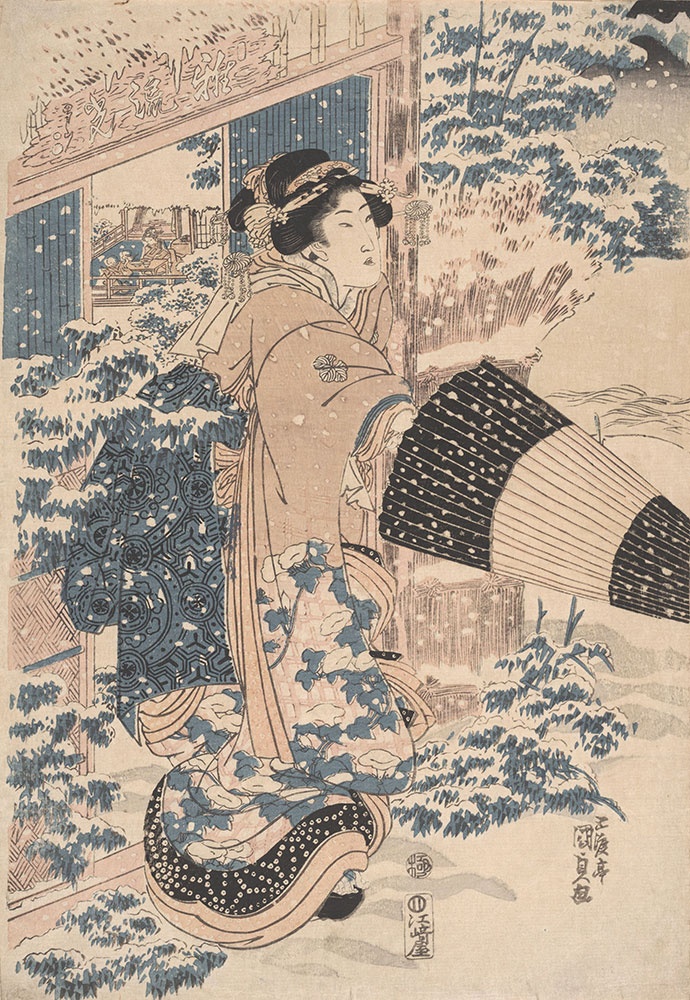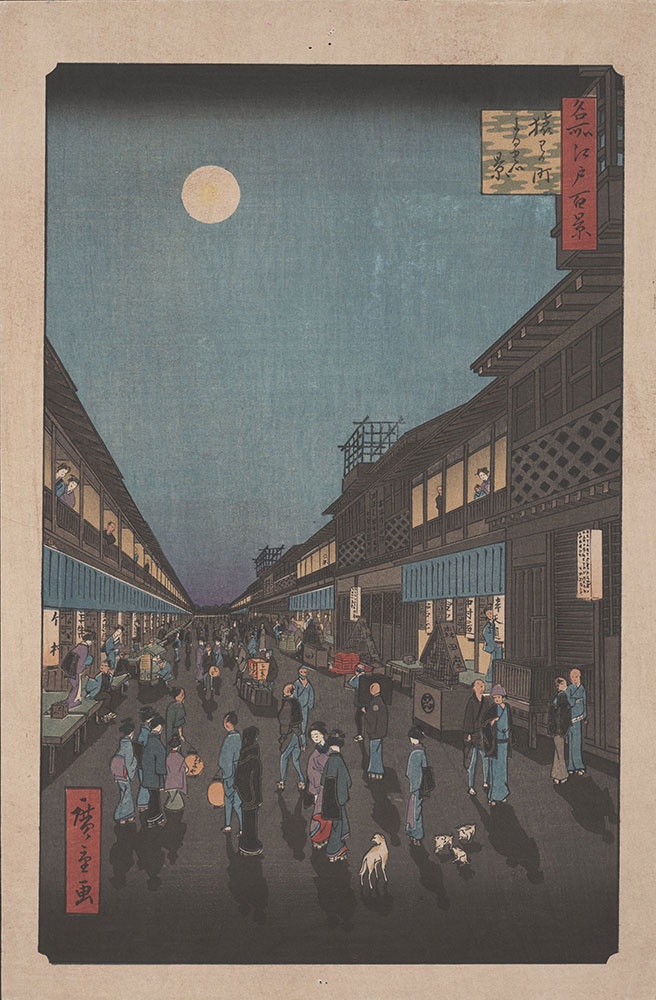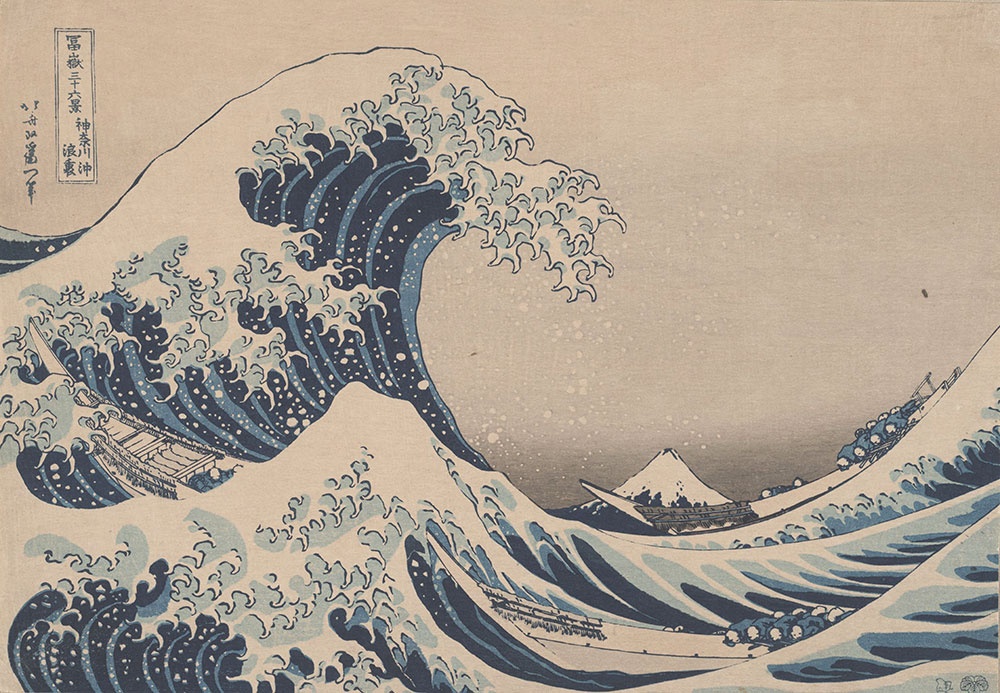I’ve been working in the Print and Picture Collection at Parkway Central Library for about a year now and I’ve still barely scratched the surface of learning about all of the art housed here. One of the first projects I was fortunate to work on was updating the collection of Ukiyo-E woodblock prints in our Digital Collections.
Even if you aren’t familiar with Ukiyo-E woodblock prints, you may have seen some examples like the famed "Under The Wave Off Kanagawa" (also known as "The Great Wave") by Katsushika Hokusai from his series, 36 Views of Mount Fuji (circa 1831).
Japanese art, and specifically woodblock printing, was not a genre I spent much time on while studying for my B.A. in Art History at Tyler School of Art. To correctly catalog and organize these prints I had to create a personal art history crash course. Several books in the Parkway Central Art Department were especially helpful and I was happy to find several informative academic lectures on YouTube.
I have always been a fan of these prints and was especially excited to be able to spend more time learning about them. The rabbit hole I went down was deep.
Here’s the thing about Ukiyo-E woodblock prints — they weren’t considered a higher art form at the time that they were produced. They were the "pop art" of their time. Prints served as souvenirs to remind their owners of their travels, dreams of travel, seeing famous Kabuki actors in plays, or beautiful Courtesans (and blush-inducing erotica). People tacked these images on the walls of their homes the way we might put a postcard on our refrigerator, discarding them when they deteriorated. The prints were meant to be a fleeting pleasure, much like their subject matter.
These woodblock prints and their content are called Ukiyo-E, a Buddhist word meaning transient, floating, or fleeting. Ukiyo-E is often called "the floating world," a term that refers specifically to the pleasure-seeking aspects of Edo Period Japan. Tokugawa Ieyasu, a Japanese military leader, founded the last shogunate and chose the quiet village of Edo (now modern-day Tokyo) as his capital. During the Edo Period (1615–1867), Japan experienced rapid economic growth. Edo’s merchant class benefited the most and began to indulge in this "floating world." This culture came out of the Yoshiwara, which was Edo’s well-known pleasure district. Edo and Yoshiwara were both the subject matter and the consumers of woodblock prints. The Yoshiwara was an area where all social constraints were suspended and people could escape to the elegant amusements offered at meeting houses, tea houses, and geisha houses.

Utagawa Kunisada, "Unknown Japanese Beauty Opening Umbrella in the Snow," 1830
Woodblock prints started as book illustrations. They were sold in bookshops or publisher’s shops. It took four people to create these prints: a publisher, an artist, a block cutter, and a printer. The publisher managed the other three by deciding what images to produce and sell based on consumer demand and competition from other publishers. The publisher then hired an artist to create the image. Once drawn, a block cutter traced the artist’s illustration to wooden blocks, often made from mountain cherry trees. This process destroyed the artist’s original work. The number of blocks carved depended on the number of colors being used for the print, as each color required its own block, along with the block for the black outlines. Once the blocks were carved, a master printer would print as many copies as possible before the blocks began to deteriorate from ink and use. Most Ukiyo-E prints are not numbered or dated but will contain the title, a signature seal, and the publisher's mark. Once finished, the prints were sold in the publisher’s shops or from street vendors.

Utagawa Hiroshige, "Night View of Saruwaka-machi," c.1858
The Print and Picture Collection houses prints by Hiroshige, Hokusai, Kunisada, Hasui, Kuniyoshi, Toyokuni, and several more celebrated Japanese artists. A large portion of the collection has been scanned and can be accessed through the Free Library’s Digital Fine Arts Collection. The collection of Japanese Ukiyo-E prints was presented to the Print and Picture Collection in memory of Mr. and Mrs. David Townsend in January 1938. Included in the collection is Utagawa Hiroshige’s "53 Stations of the Tokaido Road," which has been beautifully enclosed in portfolios with descriptions of the individual works. This set originally belonged to the Parkway Central Art Department and was transferred to the Print and Picture Collection years ago.
These original prints are especially delicate and difficult to have on display. Light presents a substantial risk because the prints were made with plant-based inks which fade quickly when exposed for long periods. A few prints in the collection already have damage from exposure and incorrect storage. Our in-house Collection Care can’t reverse the damage, but they can correctly house and preserve the prints to prevent further damage. Because of this, it is unlikely the Print and Picture Collection will be able to display the original prints. However, if you are interested in viewing the prints in person, you can email pix@freelibrary.org to schedule an appointment to view examples from the collection.
The Print and Picture Collection is open Monday through Friday from 9:00 a.m. to 5:00 p.m. for appointments.
Have a question for Free Library staff? Please submit it to our Ask a Librarian page and receive a response within two business days.

